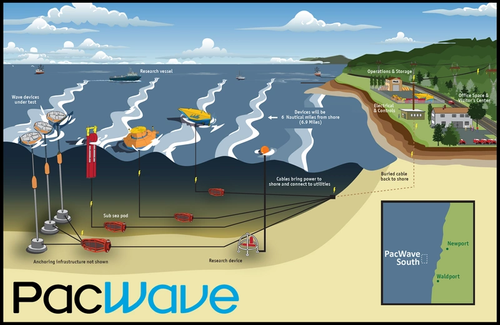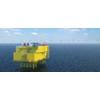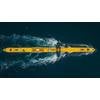BOEM Issues Lease for Wave Energy Research Project off Oregon
A pioneering project to build the U.S.’s first pre-permitted wave energy testing facility cleared a critical hurdle this week with a lease award from the Bureau of Ocean Energy Management (BOEM) to operate in federal waters about seven miles off the Oregon Coast.
The Oregon State University-led PacWave South project will be the first full-scale, utility grid-connected wave energy test site in the U.S. The estimated $80 million facility is designed to allow wave energy developers the opportunity to test different technologies for harnessing the energy of ocean waves southwest of Newport, Ore.
“This is the first time a lease has been issued to support the testing of wave energy equipment in federal waters off the U.S. West Coast,” said BOEM Director Amanda Lefton. “Ocean waves contain a tremendous amount of energy, and this opportunity offers exciting potential to demonstrate the viability of wave energy technology and expand the nation’s renewable energy portfolio.”
Marine hydrokinetic technology harnesses energy from ocean waves, tides and currents, and converts it into electricity to power our homes, buildings and cities. Experts say wave energy has the potential to provide clean, reliable electricity to meet the world’s rising energy demands. Globally, the marine energy market is projected to reach nearly $700 billion by 2050, and the World Energy Council estimates that 10% of the worldwide electricity demand could be met by harvesting ocean energy.
The 1,696 acre PacWave South site will consist of four test berths to support the testing of up to 20 floating or underwater wave energy converter (WEC) devices, with an installed capacity not to exceed 20 megawatts, to demonstrate the viability of wave energy. A WEC device converts the kinetic and potential energy associated with moving ocean waves into electrical or mechanical energy. Five power and data cables buried below the seafloor will connect the ocean test site to a shoreside facility southeast of Seal Rock.
“The PacWave team initiated this collaborative process with several federal and state agencies nearly a decade ago,” said Burke Hales, the chief scientist for the project and a professor in Oregon State's College of Earth, Ocean, and Atmospheric Sciences. “We’re excited for the opportunity to finalize this stage of the project and move a major step closer to construction.”
Lease issuance by BOEM is a prerequisite for a license from the Federal Energy Regulatory Commission (FERC), which is the federal agency that would approve project construction and operations. Oregon State officials have completed the FERC application process and are hopeful the license will be issued soon. Current timelines suggest construction could begin this summer, and the facility should be operational by 2023.
PacWave South is supported by grants from the U.S. Department of Energy, the state of Oregon and other public and private entities. Oregon State’s College of Earth, Ocean, and Atmospheric Sciences is managing the construction and operation of the facility.
“We appreciate the support of the leadership in the Department of Interior, the Bureau of Ocean Energy Management and the Department of Energy who see the value in this important work to develop alternative energy sources and have helped to move this project forward,” said Oregon State University President F. King Alexander. “We are particularly thankful for the consistent support from members of the Oregon federal delegation who have championed PacWave South from the outset, including Sens. Ron Wyden and Jeff Merkley and Reps. Suzanne Bonamici and Kurt Schrader.”














 December 2025
December 2025



